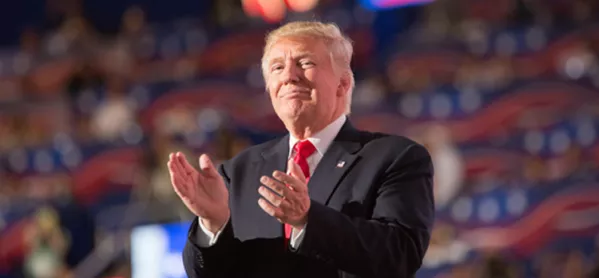- Home
- How Trump can help us teach kids to use primary sources
How Trump can help us teach kids to use primary sources

Donald Trump will today make history. His inauguration as the 45th President of the United States is the first time someone has been elected to the role with no previous political or military experience. That fact - and the huge media interest in him - will mean this is a day historians are sure to look back on in the future. And in that quest, they will have a hefty selection of primary sources to pick from.
This presents history teachers with an opportunity. Coverage will differ from one news source to another, just as it would have done in the past. So, why not use some of this coverage to illustrate the principles of using primary sources correctly?
Many history students find analysing primary source documents hard work. But it is more important than ever for young people to understand how to make use of them in this age of social media and 24-hour news.
Here are my five top tips for helping your students to get better at using primary sources.
1. Embrace contradictions
Trump is a figure who divides opinion in extreme ways. As such, the coverage today will be hugely contradictory.
Similarly, primary source documents often say things that contradict the textbook. Students tend to see this as a problem; but historians see it as a good thing. Contradictions help us to discover new information and expand our knowledge. If students can adopt the historian’s mindset and realise that their textbook cannot possibly contain the whole story, they will find it easier to use documents.
2. Choose sources that help students see ‘real people’
Textbooks are useful for providing a narrative of events. Sources are useful for revealing how people felt about those events, how they were affected, or the concerns or values which shaped events.
Once students get to know real people from the past through the documents they leave behind, they’re more likely to take a balanced view.
Documents at the National Archives, for example, can tell us that some people opposed National Insurance in 1911, not because they were stupid, but because they couldn’t afford the contributions. Insights like this one will help students to grasp the point of studying sources.
So, do a search for “Trump” on Twitter today and pull out some examples of what ‘real’ people are saying about him.
3. Show how primary sources reveal their creators
Trump has been accused of describing coverage he sees as biased as ‘fake news’. Students love to dismiss sources they believe to be biased, but this is not how historians think. If a source is biased, then somebody took the time and trouble to make it so.
This is a key rule with sources: they always tell you something about the people who created them. If you argue that a source is not useful, you may have chosen the wrong source or the wrong question. Highlight some examples from today that might prompt discussions about this.

4. Challenge widely-held views
Primary sources can be very exciting, especially when you are using them to challenge long-held views. For example, the England’s Immigrants database shows that there were thousands of immigrants living in medieval England, contrary to popular belief. Similarly, the traditional narrative of Churchill being the lone, visionary opponent of Appeasement while the majority cheered on Chamberlain doesn’t stand up to scrutinising the sources. The letters written to Churchill by his constituents (available at Churchill Archive for Schools) show that many were deeply concerned about the policy and that public opinion was divided.
Such fact-checking exercises using primary sources would be just as useful in examining Trump’s accusations of misleading comments made about him by his detractors, and the comments that Trump makes about them in return.
5. Use primary sources to promote empathy
As teachers, we ask students to show respect for others. There’s no reason why we shouldn’t extend that courtesy to people in the past. We cannot talk to those people, but we can read or listen to what they said, thought and felt. If their actions seem strange, let’s use sources to try to understand the differences between us and them. The ability to understand ‘the other’ is one of the most valuable abilities of the trained historian. And it’s a critical skill for life.
So, whichever side of the Trump fence your class sits on, let them explore the other side of the argument through primary sources today.
Ben Walsh is a GCSE history teacher and a senior examiner with a major examination board.
You can find more tips and advice on making the most of primary sources in the Churchill Archive for Schools Guide to using primary sources.
Want to keep up with the latest education news and opinion? Follow TES on Twitter and like TES on Facebook
Keep reading for just £1 per month
You've reached your limit of free articles this month. Subscribe for £1 per month for three months and get:
- Unlimited access to all Tes magazine content
- Exclusive subscriber-only stories
- Award-winning email newsletters